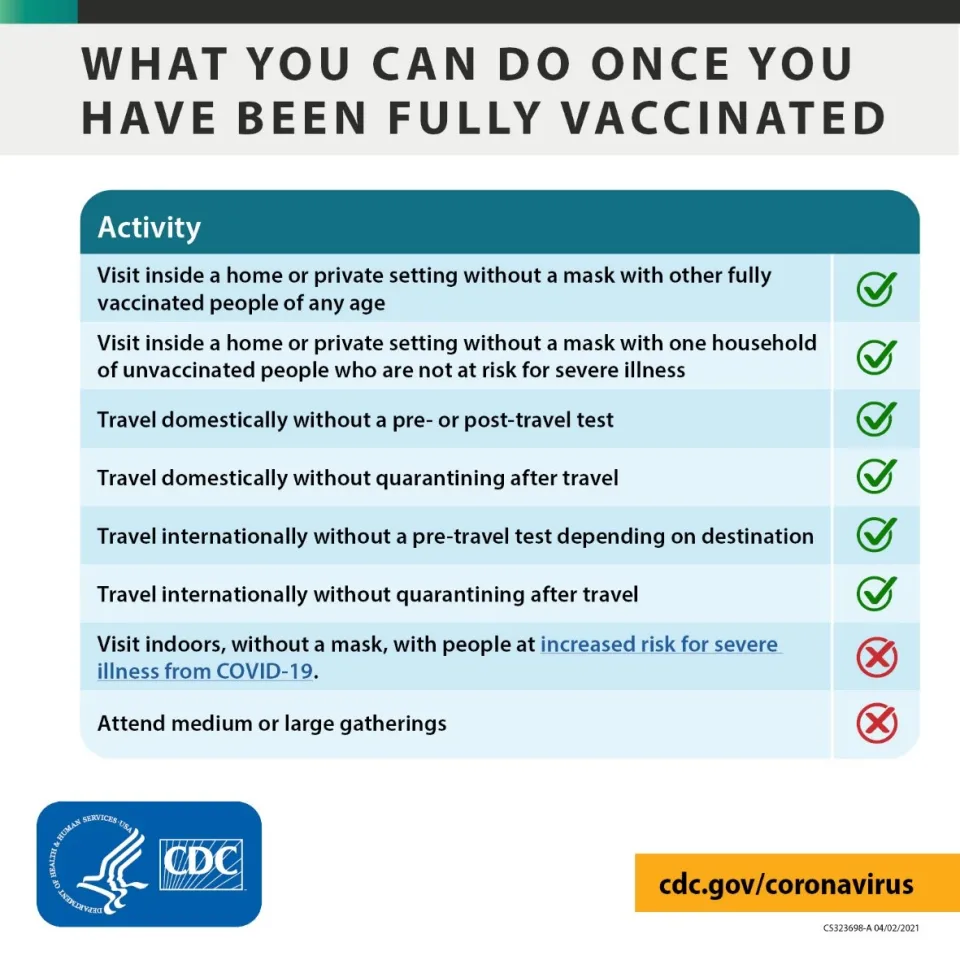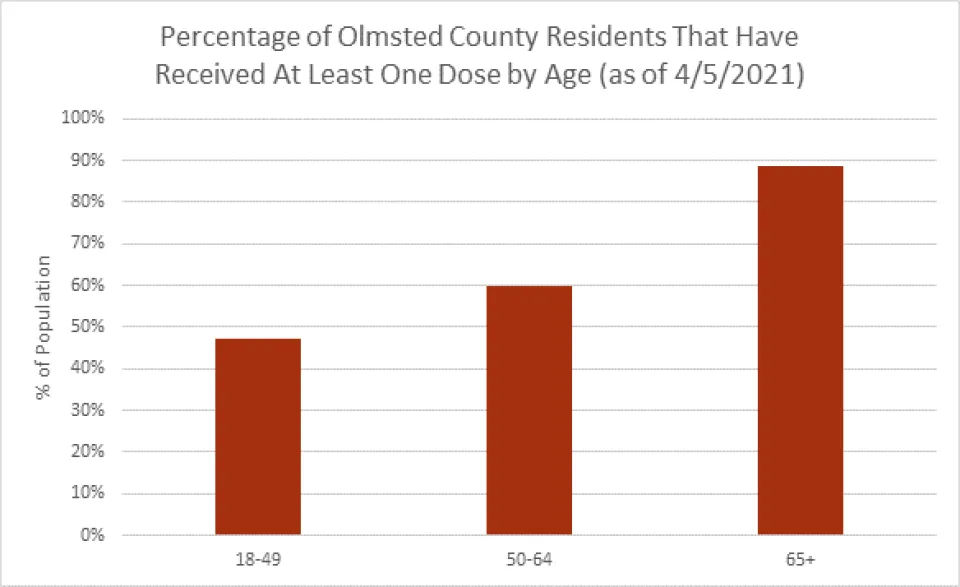COVID-19 vaccine newsletter - April 6, 2021
What’s new?
Johnson & Johnson vaccine discarded at Baltimore facility
Last week, we learned that about 15 million doses of the Johnson & Johnson vaccine were ruined at a manufacturing facility in Baltimore, Maryland. This does not affect any doses of the Johnson & Johnson vaccine currently being used or doses being allocated. The problem was quickly identified, and the doses were discarded – this is exactly what should happen during quality checks. There’s no reason to avoid getting a Johnson & Johnson vaccine.
Domestic travel update
The Centers for Disease Control and Prevention have updated domestic travel guidance. People who are fully vaccinated can travel safely within the United States.
If you are fully vaccinated, take the following steps to protect others if you travel:
- During travel
- Wear a mask over your nose and mouth. Masks are required on planes, buses, trains, and other forms of public transportation traveling into, within, or out of the U.S. and in U.S. transportation hubs such as airports and stations.
- Avoid crowds and stay at least 6 feet/2 meters (about two arm lengths) from anyone who is not traveling with you.
- Wash your hands often or use hand sanitizer (with at least 60% alcohol).
- After travel
- Self-monitor for COVID-19 symptoms; isolate and get tested if you develop symptoms.
- Follow all state and local recommendations or requirements.
You do NOT need to get tested or self-quarantine if you are fully vaccinated or have recovered from COVID-19 in the past three months. You should still follow all other travel recommendations.
CDC recommends delaying travel until you are fully vaccinated because travel increases your chance of getting and spreading COVID-19. If you are not fully vaccinated and must travel, follow CDC’s recommendations for unvaccinated people.


Updates
Olmsted County Public Health Services (OCPHS)
Steady progress continues to be made – over 41% of Minnesotans have had at least dose of vaccine, and 27% are fully vaccinated. In Olmsted County, 88.6% of those 65 and older and 60.2% of those aged 50-64 have received at least one dose. Nearly 50% of our population ages 18-49 and roughly 10% of our population ages 16-17 have received at least one dose.

OCPHS continues to prioritize essential workers and employers per the Governor’s order and is giving priority to businesses who have completed the COVID-19 Vaccination Planning for Business Form. Beginning this week, OCPHS is also offering the COVID vaccine to people who register in advance. Vaccine clinics are by appointment only and are first come, first served. The Olmsted County vaccine page will be updated with new dates and times based on OCPHS’ vaccination allocation. Individuals should check the website daily.
Mayo Clinic
Mayo Clinic will continue to follow a balanced approach, in accordance with state directives, as it continues to prioritize vaccination for patients. Mayo will send vaccine appointment invitations to patients with underlying conditions and as vaccine supply allows, increase vaccination opportunities for Minnesota residents who are 16 and older.
Mayo Clinic patients who have a Patient Online Services account are invited to check the New Appointments section to see if appointments are available. If you don't have a Patient Online Services account, call Mayo Clinic Customer Assistance at 877-858-0398 (toll-free) to create one. If no appointments are available, check back as appointments are released as vaccine is received, or check the VaccineFinder page at the Centers for Disease Control and Prevention, or the Vaccine Connector at the MDH website, which lists vaccination location information.
It may take several weeks to accommodate all patients eligible to receive vaccine in Rochester. If you find an earlier opportunity through another provider who has vaccine on hand, you should take it.
Olmsted Medical Center (OMC)
As announced, all people 16 years of age and older are now eligible to receive the COVID-19 vaccine in Minnesota. Please be aware that while all patients 16 years and older are eligible, not everyone will be able to be vaccinated right away. This is because the demand for the vaccine is much greater than the supply. It will take time and patience to vaccinate all patients who want to be vaccinated. OMC will continue to use a randomized process for determining who will be offered a vaccination time slot.
Based on Governor Walz’s recommendations, OMC will continue prioritizing the vaccine for patients with underlying health conditions, those who are at a higher risk of getting COVID-19, those who could develop severe illness if infected with COVID-19, and those in the remaining priority groups:
- Age 16+ with one or more of the following underlying conditions: Sickle cell disease, Down syndrome, Chronic Kidney Disease (CKD), Chronic Obstructive Pulmonary Disease (COPD), cancer, heart conditions, immunocompromised, obesity, Diabetes Type 1 or 2, and pregnancy.
- 65+.
OMC will reach out to patients in the following ways:
- If you have an OMC MyChart patient portal account, a message will be sent to you through the portal.
- If you have email notifications for messages turned on, the email will read “a new COVID-19 vaccine scheduling ticket available in OMC MyChart.”
- If you do not have an OMC MyChart account, you will be contacted by phone or text message.
Education / Information
Have you been fully vaccinated?
People are considered fully vaccinated:
- 2 weeks after their second dose in a 2-dose series (Pfizer and Moderna).
- 2 weeks after a single-dose vaccine (Johnson & Johnson).
If you don’t meet these requirements, you are NOT fully vaccinated. Keep taking all precautions until you are fully vaccinated.
National Public Health Week is April 5-11
National Public Health Week provides opportunities for the public to learn more about the many contributions made by public health professionals throughout our nation, state, and here in Olmsted County. This year's campaign theme is "Building Bridges to Better Health."
Public Health work is often invisible and involves many individuals working quietly behind the scenes. This work provides the foundation of health where we live, work, age, worship, and play.
- 90% of the nation’s health care costs are for people with chronic conditions, and the majority of those costs are preventable. State and local public health agencies are leading community-driven solutions to expand opportunities that support behavior change through policies, systems, and environmental changes.
- Public health professionals help communities prevent, prepare for, withstand, and recover from the impact of a full range of health threats, including disease outbreaks such as the COVID-19 pandemic, measles, natural disasters, and disasters caused by human activity.
- Public health action, together with scientific and technological advances, has played a major role in reducing and, in some cases, eliminating the spread of infectious disease, and in establishing today’s disease surveillance and control systems.
- The COVID-19 pandemic has illuminated the value of a national public health system that monitors the welfare of the entire population, ensures its security and protects it from the spread of infectious disease and environmental hazards, and helps to ensure access to safe and quality care to benefit the population.
- The Olmsted County Public Health staff, and others within Olmsted County have provided countless hours of dedicated service and have taken on new and challenging tasks outside their normal job duties, limiting the impact of the COVID-19 pandemic locally in partnership with health care and other organizations in the community.
Olmsted County residents have been a critical part of our local public health system this past year. They have experienced loss and disruption to their daily lives while demonstrating adaptability and determination to follow public health guidelines to lessen health risks due to COVID-19 for others in our community. Together, we are providing the foundation for a vibrant and healthy community.
